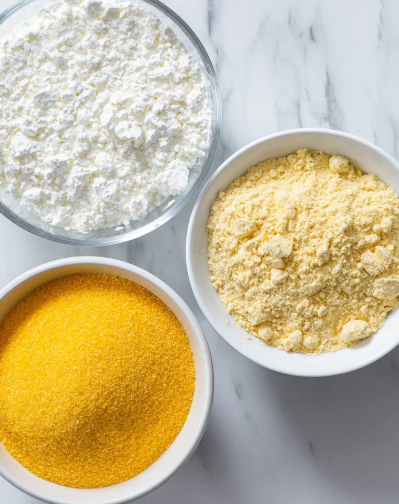
Is Cornstarch Gluten-Free? What You Need to Know for a Safe Gluten-Free Diet
Cornstarch is a widely used ingredient in both cooking and baking, known for its ability to thicken sauces, soups, and gravies. It’s also a key component in gluten-free baking, helping to provide structure and texture to cakes, cookies, and breads. As it continues to grow in popularity, many wonder: Is cornstarch gluten-free?
The short answer is yes, cornstarch is naturally gluten-free, but there are some important considerations for those with celiac disease or gluten sensitivities. In this post, we’ll explore what you need to know about cornstarch, its potential risks, and how to ensure it’s safe for a gluten-free diet.
What is Cornstarch?
Cornstarch is a fine, white powder made from the endosperm of corn kernels. While it’s technically a form of pasta, it’s commonly classified as a starch and used as a thickening agent in many recipes. It can help create smooth textures in sauces, gravies, soups, puddings, and more.
Though it’s a staple in kitchens worldwide, cornstarch is also widely used in processed foods to improve texture, prevent clumping, and enhance product stability. In gluten-free recipes, cornstarch can be used to replace wheat flour, helping to maintain the desired consistency and tenderness.
Is Cornstarch Gluten-Free?
Yes, cornstarch in its pure, unmodified form is naturally gluten-free. Since it’s made from corn, which doesn’t contain gluten, cornstarch doesn’t either. This makes it a safe option for people with celiac disease or gluten sensitivity. Unlike wheat, barley, or rye, corn is gluten-free, so using cornstarch in your cooking or baking won’t trigger gluten-related issues.
However, there are some precautions to keep in mind. During production, cornstarch can become contaminated with gluten if it’s processed in facilities that also handle gluten-containing grains. This is particularly important for individuals with severe gluten sensitivities or celiac disease, as even trace amounts of gluten can cause adverse reactions.
Cross-Contamination Risk
While cornstarch itself doesn’t contain gluten, cross-contamination can occur when it’s produced in facilities that process other gluten-containing grains. To minimize the risk of gluten exposure, always check the product label. Look for cornstarch that is certified gluten-free or explicitly states it’s produced in a gluten-free facility. These labels offer peace of mind by ensuring that the product has been rigorously tested and meets strict gluten-free standards.
Modified Cornstarch and Gluten: What to Know
You may also come across modified cornstarch in many packaged foods. This simply means that the cornstarch has undergone a physical or chemical process to improve its performance, such as in sauces or processed meals. While modified cornstarch is typically made from corn and remains gluten-free, the source of modified starch can vary by region. Outside of North America, modified starch might be derived from wheat, rice, or other grains, which could contain gluten.
To avoid any gluten risks, always check the ingredient list carefully. If the modified starch contains wheat, it will be listed under allergen labeling requirements. When in doubt, stick to cornstarch that is certified gluten-free.
How to Safely Use Cornstarch
For those on a gluten-free diet, cornstarch can be a valuable ingredient in your kitchen. To use it safely, keep these tips in mind:
-
Choose Certified Gluten-Free Brands: Look for trusted brands like Argo or Bob’s Red Mill, which offer cornstarch that’s certified gluten-free and produced in dedicated facilities.
-
Check the Labels: Even though cornstarch itself is gluten-free, cross-contamination during packaging or processing can occur. Always read labels for any gluten warnings, such as “processed in a facility that also processes wheat.”
-
Avoid Bulk Bins: Bulk food bins may carry a higher risk of cross-contact with gluten-containing ingredients. If you buy cornstarch from a bulk bin, make sure it’s clearly labeled gluten-free.
Cornstarch Alternatives for Gluten-Free Diets
If you’re looking for alternatives to cornstarch, there are several options that work well in gluten-free cooking:
-
Arrowroot Powder: A gluten-free starch that works as a thickener for soups, sauces, and puddings. It has a neutral flavor and is great for both sweet and savory dishes.
-
Potato Starch: A versatile alternative that can thicken stews, soups, and baked goods. Potato starch offers a smooth texture and is great for adding moisture to gluten-free cakes.
-
Tapioca Flour: Also known as tapioca starch, this flour is made from the cassava root and is a great gluten-free option for thickening puddings and sauces. It also provides a chewy texture for gluten-free breads and pies.
Each of these alternatives has its own unique properties, so it’s important to choose the right one based on your specific recipe and desired texture.
Conclusion
Cornstarch is naturally gluten-free, making it a safe and versatile ingredient for individuals with gluten sensitivities or celiac disease. However, due to the risk of cross-contamination during processing, it’s essential to select certified gluten-free cornstarch or products that are specifically labeled as gluten-free.
By carefully reading labels and choosing trusted brands, you can safely enjoy cornstarch in your cooking and baking. For those who prefer alternatives, there are plenty of gluten-free starches available, such as arrowroot powder, potato starch, and tapioca flour, that work just as well in recipes.




